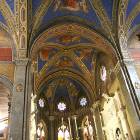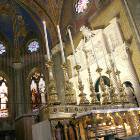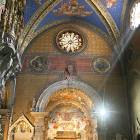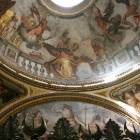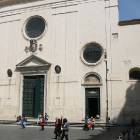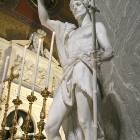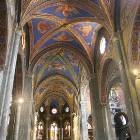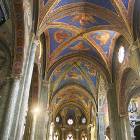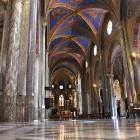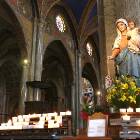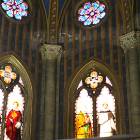Basilica of Santa Maria sopra Minerva, the only Gothic church in Rome
You would not be able to tell it has a Gothic structure on the inside, from the unsuspecting, modest Baroque facade. That is a later addition and its flat low height wall only makes the church blend in with the rest of the buildings on the street.
On the inside, the height of the church gets surprisingly higher, with vaults painted in the style of French Gothic. The blue background of the ceiling with intersecting arches, adorned with red and golden stars, makes an impression to the visitor. The chapel of Thomas Aquinas, whose remains were here for a while, is highly decorated, with frescoes presenting the Assumption and the Annunciation. This chapel and a marble statue of Jesus, by Michelangelo, are from the Renaissance period.
The name and history of this church stand proof of the long transition period, in which pagan practices and beliefs were blended in the Christian faith. This place in Rome was occupied by pagan temples to Minerva (Roman goddess of Wisdom and Justice) and to Isis (Egyptian goddess, mother of Horus, the sun-god). Though Romans remained in history as rather practical people, preoccupied with military campaign, legislation and building cities, they were a sponge for beliefs of neighboring nations. They not only borrowed the entire Pantheon of the Greeks, but also found equivalences with their gods and those of the Orient, adding them when they considered them to fill an empty spot. Emperor Diocletian brought in front of the temple of Isis, where the church of Sopra Minerva now stands, an obelisk. This obelisk was later embellished, during Renaissance, and is one of the numerous Egyptian obelisks in Rome, being connected with the mythical story of Isis recomposing the body of Horus.
It’s very revealing that in the middle of the 8th century, this place was still a pagan temple, although indeed in a state of ruin. But now that past is long forgotten. The Gothic age is visible in the aisles on the sides of the nave, where tall marble columns end in intersecting arches. The colorful stained glass, with typical Gothic rose flower shape, give natural light to the interior. The pointed shape of the large windows behind the main altar is also typical. The painted walls and ceiling represent a nice transition, from the often somber look of the Gothic, to the more colorful taste of Renaissance.
The Renaissance is present in the frescoes that decorate the round dome with an ocular, supported on painted pendants. From the same age dates a statue of John the Baptist, by Giovanni Obici. A newer, painted statue presents the Virgin Mary with Child, reminding the dedication of this church to Santa Maria.
Mai multe despre: Italia, Religious architecture • catholic church • fresco • gothic architecture • Italy • John the Baptist • Michelangelo • Minerva • Renaissance • Rome • Santa Maria • Santa Maria Minerva • sculpture- Home Page
start page - Architecture
landmark buildings - Sacred architecture
places of worship - Nature
landscape photography - Concert
performing artists - Christmas
Santa Claus pictures
- Jooble
jobs for photographers - Escape
an out of control blog - Merry Christmas
The best organizer of Christmas parties - Astro photo
Eclipse hunting and astrological photography

